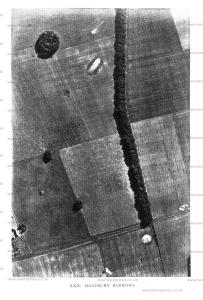Wessex from the Air Plate 30
Wessex from the Air Plate 30 is in Wessex from the Air.
Reference No. 163. Geological Formation. Upper Chalk. County. Hants. 31 NW. (122: E. 12). Time and Date of Photograph. 6.4 p.m., 26th June. Parish. Nether Wallop. Height of Aeroplane. 3,300 ft. (1,006 metres), Latitude. 51° 8' 34" N. Longitude. 1° 32' 22" W. Speed of Shutter, 1/80th of a second. Height above Sea-level. A little over 300 ft. (91 metres).
There are three barrows visible on this plate, two long barrows and one oval barrow.
The two long barrows [Danebury Barrow 1 [Map] and Danebury Barrow 2 [Map]] were discovered by Dr. Williams-Freeman, and are referred to in his book (Field Archaeology of Hampshire, 1915, p. 155). In spite of being annually ploughed over, they are both still in a good state of preservation. The dark lines of the parallel side-ditches can be clearly seen on the plate. The two barrows are 180 ft. apart; and lie about 600 yds. north-west of Danebury.
The south-western barrow is 213 ft. long: from the bottom of the ditch to the highest point of the barrow is 9 ft. 6 in., and the top of the ditch itself is i ft. 8 in. below the adjacent ground level. The orientation is 118° Magnetic (1924).
The north-eastern barrow is 177 ft. long and 6 ft. 7 in. high; the ditch is i ft. 3 in. below ground-level; and the orientation is 110° Magnetic (1924).

The oval barrow [Map] was discovered by me. Before I saw it from the air, I regarded it as a short long barrow. Its length is 110 ft.; its breadth 80 ft.; and its height 5 ft. 4 in. From the air, however, as this plate shows, it is plainly revealed as not a long barrow. It has interesting features, however; it is made of dug chalk, not scraped soil; and it is probable from the size and irregularity of the black belt marking the ditch, that the material of the mound was entirely derived from the surrounding ditch. That is an unusual feature in round barrows. Normally, the mound was piled first and the ditch dug afterwards; and it was generally far too small to have provided all the material for the mound." In the case of long barrows, as is well seen here, the material of the mound was always entirely derived from the side-ditches; and one would imagine that round or oval barrows constructed in the same way would, therefore, be earlier than the others; the encircling ditch being retained by custom after its original utilitarian purpose was forgotten. Unfortunately, the data for testing this a priori reasoning are not adequate. But one of the barrows on Handley Down excavated by General Pitt-Rivers may be described here, since in method of construction it seems to have resembled the oval barrow here— so far as we can infer from the air-photograph.
The barrow (no. 27) is described in vol. iv of the General's Excavations, pp. 136—8. It lay on Handley Down, Dorset, 104 yds. to the north of Wor Barrow, the celebrated long barrow that he excavated completely. ' It was found that beneath the mound a very irregular ditch had been dug, varying in depth from 2 ft. to 4½ ft. in different places, and of irregular width and outline, conforming only more or less to the fine of the bottom of the barrow, and having cavities and separate pits, evidently dug for the same purpose of obtaining chalk and earth for the barrow; but with no intention of forming a symmetrical ditch round it.' This irregularity resembles that of the side-ditches of Wor Barrow, which were fully cleared out. Evidence of early date was found in the character of the potsherds from the ditch and interior of the mound; all the potsherds (five in number) from the interior, found together at a depth of 1 ft. were of the General's 'No. 1 British' quality: and of those found in the ditch — 54 in were 'No. 1 British', one was 'beaker', and one of later date. It is safe to conclude that the barrow was not later than the period of the bulk of the potsherds, that is to say, than the neolithic period, or possibly, the Early Bronze Age. (No primary interment or cist seems to have been found.)
It is much to be desired that the oval barrow here portrayed should be excavated, under expert supervision, to determine the age of this type of mound.